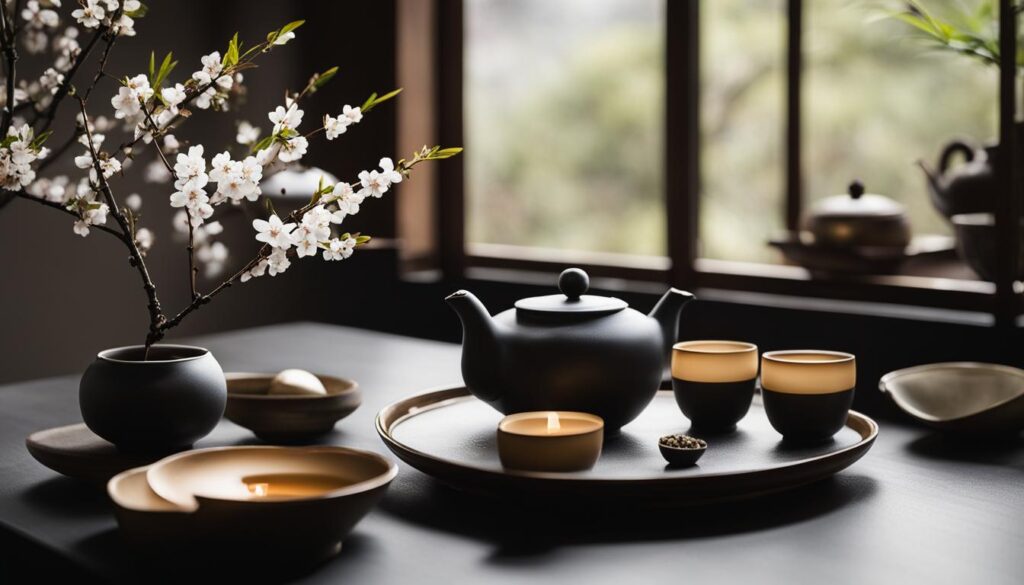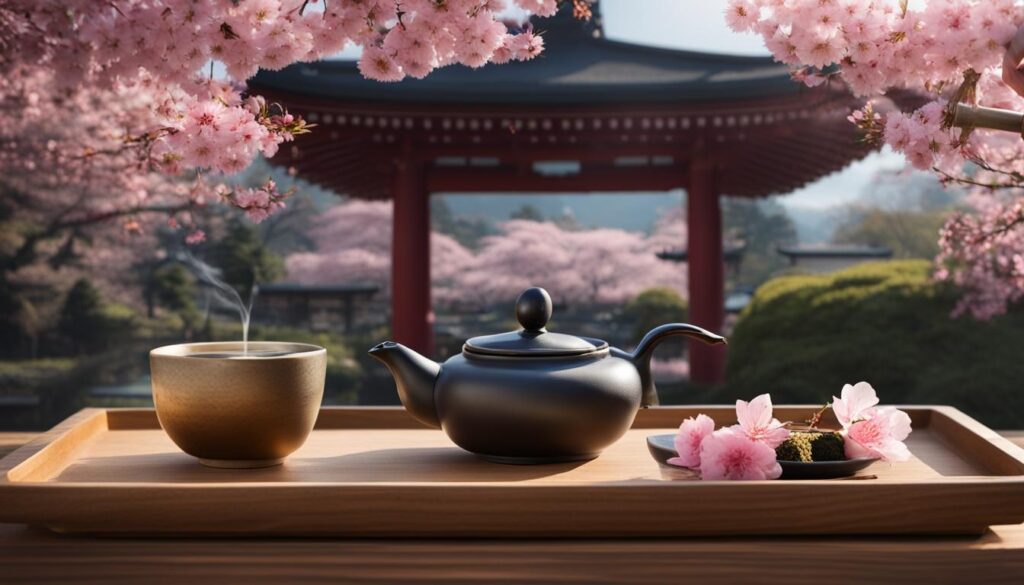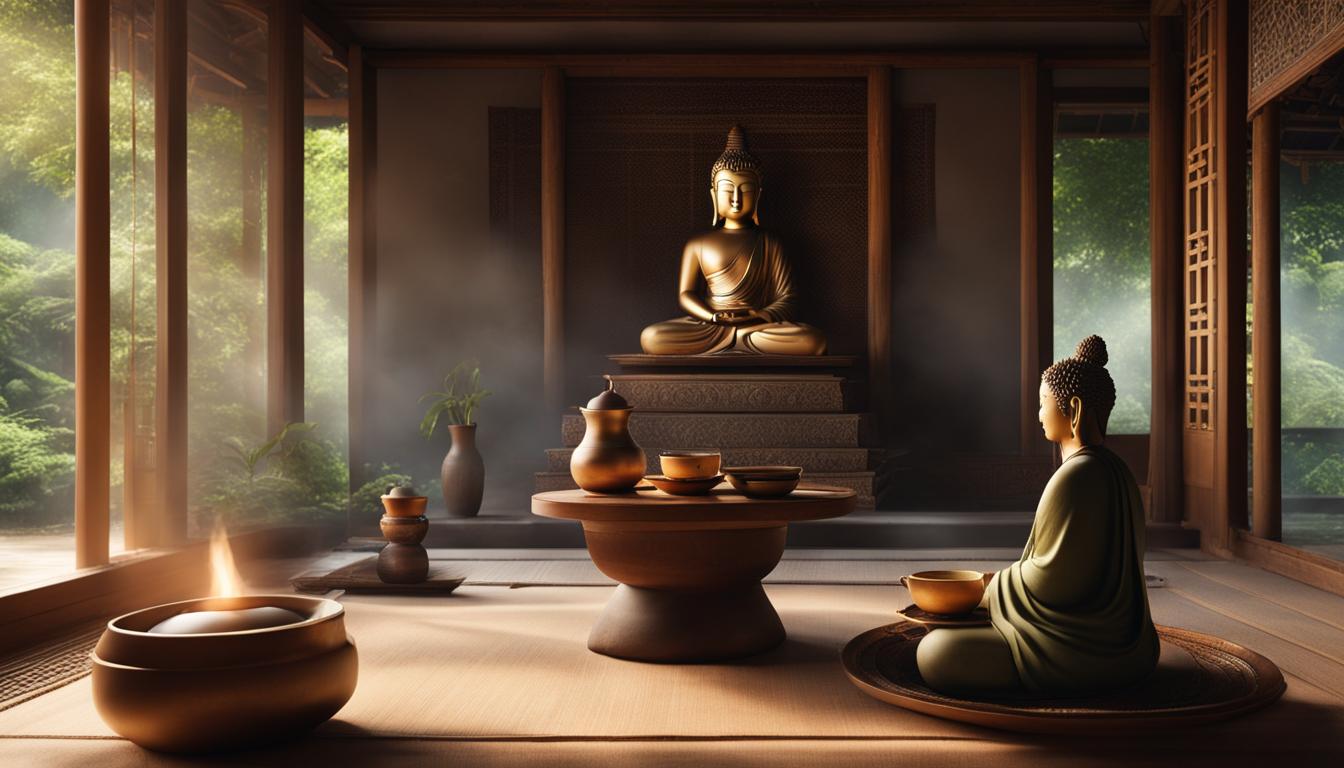Gather around as we explore the captivating influence of Buddhism on traditional tea ceremonies. Prepare to be enlightened as we delve into the rituals, practices, and philosophies that have shaped this ancient tradition. From Buddhism’s pivotal role in tea production methods to the development of formalized ceremonies, we uncover the harmonious blend of spirituality and tradition that defines tea culture.
Tea and Buddhism, a natural pairing that evokes feelings of calm, meditation, and ceremony. Did you know that Buddhist monks were instrumental in domesticating the wild tea tree, perfecting cultivation techniques, and formalizing the art of tea preparation? It’s true! Join us on this journey through time as we explore the profound impact that Buddhism has had on tea ceremonies in China, Japan, and Korea.
Key Takeaways:
- Buddhism has played a crucial role in the development of tea production methods and the social context surrounding tea.
- Tea ceremonies in Buddhist traditions promote mindfulness, meditation, and the cultivation of inner peace.
- Buddhist principles and practices are deeply ingrained in the rituals and philosophies of tea ceremonies.
- The Japanese Tea Ceremony, or Chanoyu, is an art form that embodies harmony, respect, purity, elegance, and tranquility.
- The influence of Buddhism can still be seen in tea cultures around the world, highlighting the enduring legacy of this ancient tradition.
Buddhist Principles and Practices in Tea Ceremonies
Buddhist principles and practices are deeply ingrained in tea ceremonies. The ritual of tea drinking became an integral part of the daily routines in Buddhist temples during the Tang dynasty, around 1200 years ago. Monasteries and temples played a significant role in the professionalization of tea growing and the dissemination of tea-related knowledge.
The Buddhist monks not only spread tea cultivation to Japan but also developed alternative techniques such as pan-frying as a method of tea production. They also formalized the ceremony and ritual of tea preparation, emphasizing respect, harmony, purity, and peace. These principles continue to be upheld in tea ceremonies in Buddhist traditions, promoting mindfulness and meditation through the ritual of tea drinking.
The monastic tea ceremonies have stood the test of time and continue to be practiced today, allowing individuals to connect with themselves and find tranquility amidst the chaos of life. The serene and meditative nature of tea ceremonies in Buddhist monasteries provides a much-needed respite from the fast-paced world we live in.
“Tea is a way of life, and it is through the practice of tea ceremonies that we find solace and inner peace.”
Buddhist Monastic Tea Ceremonies
In Buddhist monastic tea ceremonies, each step of the tea preparation process is performed with utmost mindfulness and intention. The preparation of the tea involves precise movements that symbolize respect for the tea leaves, the water used, and the act of drinking itself.
Tea ceremonies in Buddhist monasteries serve as a reminder to be present in the moment, to appreciate the simplicity of life, and to cultivate inner peace and tranquility. These ceremonies offer a space for reflection and introspection, allowing participants to tap into their spirituality and find a sense of calm.
| Key Aspects of Buddhist Monastic Tea Ceremonies | Explanation |
|---|---|
| Mindfulness | The entire process of tea preparation and consumption is performed with utmost mindfulness, focusing on each movement and sensation. |
| Harmony | Tea ceremonies emphasize the importance of harmonious interactions, both with oneself and with others. |
| Purity | Purity of mind and body is valued, with participants often engaging in cleansing rituals before partaking in the tea ceremony. |
| Peace | The aim of the tea ceremony is to create a sense of peace, both internally and externally, fostering a state of calmness and serenity. |
Tea ceremonies in Buddhist monasteries not only provide a spiritual experience but also promote a sense of community and connection among participants. Through the act of sharing tea, individuals come together, breaking down barriers and finding common ground.
Tea as a Spiritual and Pragmatic Offering in Buddhism
Tea holds a dual role in Buddhist culture, serving as both a spiritual offering and a pragmatic solution to social and health challenges. In Buddhist temples, tea ceremonies are not just about the act of drinking tea; they are also a means of creating a moment of calm and renewal. Buddhist meditation in tea ceremonies allows practitioners to cultivate mindfulness and experience the present moment fully. The act of preparing and drinking tea becomes a form of meditation in itself, promoting inner peace and tranquility.
But tea also serves a practical purpose in Buddhist monastic communities. It offers a safe alternative to potentially contaminated water, which often caused diseases. By boiling water for tea, people could ensure its safety and avoid waterborne illnesses. Tea became an essential part of daily life in Buddhist monasteries, providing mild stimulation and hydration throughout the day. Additionally, tea played a role in the development of meditation practices, as it provided caffeine to help monks maintain focus during long meditation sessions.
Overall, the spiritual and practical significance of tea in Buddhism is deeply intertwined, making it an integral part of Buddhist culture and tradition. Tea ceremonies not only create a sense of tranquility and spiritual connection but also offer a pragmatic solution to social and health challenges. The act of preparing and drinking tea becomes a mindful practice that aids in meditation and promotes inner peace.

Buddhist-Inspired Themes in the Chanoyu – Japanese Tea Ceremony
The influence of Buddhism on tea ceremonies extended beyond China and reached Japan, where it evolved into the refined art form known as the Japanese Tea Ceremony, or Chanoyu. Originating as a habit of Chinese Buddhist monks to aid their meditation practice, the Japanese Tea Ceremony became a cultural tradition embraced by Japanese aristocrats, showcasing their appreciation for aesthetics and their unique cultural identity. Zen Buddhism heavily influenced the development of the tea ceremony in Japan, emphasizing simplicity, mindfulness, and the appreciation of the present moment.
One of the key elements of the Japanese Tea Ceremony is the incorporation of Buddhist-inspired themes. The ceremony is designed to create a sense of harmony, respect, purity, elegance, and tranquility. Each aspect of the ceremony, from the preparation of the powdered green tea called matcha to the layout of the tearoom and the utensils used, is carefully designed to evoke a meditative atmosphere and promote mindfulness.
The interplay of different elements in the Chanoyu creates a visual and sensory experience that engages all the senses. The use of specific utensils, such as the tea scoop, tea whisk, and tea bowl, carries symbolic meaning and adds to the overall aesthetic beauty of the ceremony. The tea utensils are often carefully selected for their craftsmanship and historical significance, further connecting the participants to the rich cultural heritage of Japan and Buddhism.
| Symbolic Elements in the Chanoyu | Meaning |
|---|---|
| Chabana (tea flowers) | Represents the fleeting beauty of nature and impermanence. |
| Rocks and sand | Symbolizes a miniature landscape, invoking the serene and contemplative nature of Buddhist gardens. |
| Incense | Aids in creating an atmosphere of tranquility and meditation. |
| Calligraphy and artwork | Decorative scrolls featuring Buddhist teachings and art add to the serenity and cultural richness of the tearoom. |
The Buddhist-inspired themes in the Chanoyu not only enhance the aesthetic experience but also serve as a reminder of the principles of Buddhism, promoting introspection and self-reflection. Through the practice of the Japanese Tea Ceremony, participants can connect with their inner selves, find inner peace, and appreciate the beauty of the present moment.

Conclusion
The influence of Buddhism in shaping traditional tea ceremonies is undeniable. From its impact on tea production methods to the development of refined ceremonies in Buddhist temples and monasteries, Buddhism has left an indelible mark on tea culture.
Tea ceremonies in Buddhist traditions promote mindfulness, meditation, and the cultivation of inner peace. The principles of respect, harmony, purity, and peace are central to both Buddhism and tea ceremonies, creating a shared sense of tranquility and spiritual connection.
Today, the influence of Buddhism can still be seen in tea cultures across the world, as people continue to appreciate the beauty and serenity that tea ceremonies bring. Buddhism’s role in tea ceremonies is a testament to the enduring legacy of this ancient tradition and its ability to shape and enrich our understanding of tradition and spirituality.
FAQ
How has Buddhism shaped traditional tea ceremonies?
Buddhism has had a profound impact on tea ceremonies, influencing their rituals, practices, and philosophies. Buddhist monks played a crucial role in the development of tea cultivation techniques, the domestication of wild tea trees, and the formalization of the ceremony and ritual of tea preparation.
When did tea drinking become a part of Buddhist temples’ daily routines?
Tea drinking became a part of the daily routines in Buddhist temples during the Tang dynasty, around 1200 years ago. Monasteries and temples played a significant role in the professionalization of tea growing and the dissemination of tea-related knowledge.
What principles and practices of Buddhism are ingrained in tea ceremonies?
Buddhist principles such as respect, harmony, purity, and peace are deeply ingrained in tea ceremonies. The ceremony and ritual of tea preparation were formalized by Buddhist monks, emphasizing these principles and promoting mindfulness and meditation through the act of tea drinking.
What role does tea play in Buddhist culture?
Tea holds a dual role in Buddhist culture. It serves as a spiritual offering, creating moments of calm and renewal, and as a pragmatic solution to social and health challenges. Tea was a safe alternative to contaminated water, providing hydration and mild stimulation to Buddhist monastic communities. Additionally, tea’s caffeine content aided monks in maintaining focus during long meditation sessions.
How did tea ceremonies evolve in Japan?
Tea ceremonies in Japan, known as Chanoyu, originated as a habit of Chinese Buddhist monks to aid their meditation practice. Over time, it became a cultural tradition embraced by Japanese aristocrats and an art form that embodied harmony, respect, purity, elegance, and tranquility. Zen Buddhism heavily influenced the development of the Japanese Tea Ceremony, emphasizing simplicity, mindfulness, and the appreciation of the present moment.





